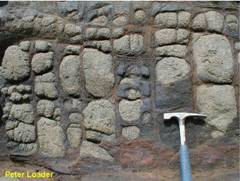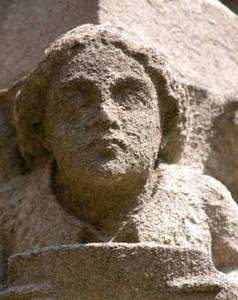Hydrolysis
Hydrolysis takes place when acid rain reacts with rock-forming minerals such as feldspar to produce clay and salts that are removed in solution.
The only common rock-forming mineral that is not affected is quartz, which is a chemically resistant mineral. This is why quartz and clay are the two of the most common minerals in sedimentary rocks.
The only common rock-forming mineral that is not affected is quartz, which is a chemically resistant mineral. This is why quartz and clay are the two of the most common minerals in sedimentary rocks.
Spheroidal weathering
The weird shapes form as water attacks the rock along joints and cracks, leaving rounded lumps of un-weathered rock.The iron-rich minerals in the rock have also oxidised to a brown “rusty” colour.

Spheroidal weathering by hydrolysis, Holy Island, Anglesey.

Church carving showing effects of hydrolysis.

